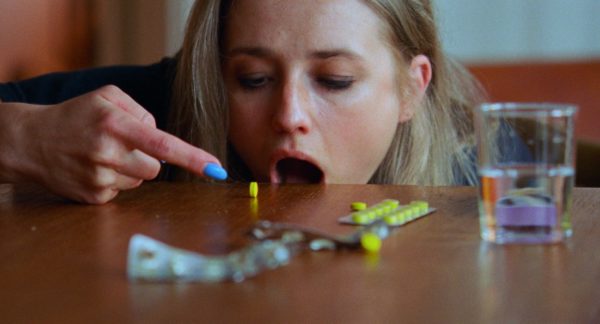Film Review: London Film Festival Dispatch #2 — “Sick of Myself” and “Triangle of Sadness”
By Peg Aloi
Two over-the-top social satires take sharp swipes at modern excesses.

A scene from Triangle of Sadness.
These two films at the BFI London Film Festival are both stellar examples of dark social satire that are out to skewer pervasive aspects of popular culture. Rubin Östlund’s Triangle of Sadness (which was also reviewed for The Arts Fuse by Erica Abeel) proved such a popular selection at this year’s festival that several additional screenings were added. It is not surprising, given that the film won the coveted Palme d’Or, the top prize at the Cannes Film Festival. Östlund’s previous films, Force Majeure and The Square, were Euro-focused (French and Dutch respectively). This one is primarily in English. I saw it in an enormous and gorgeous venue,, the Royal Festival Hall in London, which was completely full. Audience response was raucous and expressive, particularly during the now notorious scenes that feature minutes and minutes of violent vomiting after the passengers on a luxury yacht succumb to a combination of food poisoning and sea sickness. But, despite the ubiquitous mention of that (hard to watch yet compelling) sequence, the film’s overall focus is to comment on the privileges conferred by wealth and status.
To me, the most intriguing aspect of Triangle of Sadness was the concept of personal worth and social power assigned to both money and beauty. Youth and good looks are initially offered up as the most valuable assets one can possess, followed by material and monetary heft. A young model, Carl (Harris Dickinson), opens the film in a brutally funny scene that parodies the fashion industry. Carl and his girlfriend Yaya (Charlbi Dean, a fine actress who died tragically after filming was completed at age 32) are at the center of the plot, their ambition and selfish behavior the requirements for the membership in elite society. One character straddles the divide between social status and utilitarian function: the ship’s captain, played with gleeful abandon by Woody Harrelson. Jaded and lazy, he dreads his interactions with the yacht’s guests and drinks heavily when he’s supposed to be alert and in control. The crux of the film occurs as the yacht passengers struggle to survive after their ship runs aground on a tropical island. The shift in authority and dominance is almost immediate. The uber-rich and beautiful, accustomed to being served, find themselves helpless dependent on the people who have the pragmatic skills to deal with the unexpected — the crew members who previously served them. The film is quite relentless, fast paced and unflinching in its juxtaposition of grotesque corporeality with bodily perfection. The international cast is letter-perfect, especially Dolly de Leon, whose role initially seems to be minor until it becomes pivotal: Dickinson as Carl, the gorgeous model troubled by his lack of financial success, and Zlako Buric as a Russian millionaire whose jovial manner and naked greed make him a strangely alluring narcissist.
There’s a whiff of Lord of the Flies‘ gloom and doom, but Östlund sprinkles these intimations of mortality with plenty of wicked humor. Triangle of Sadness is an entertaining film, perhaps holding back from being as hard-hitting as it might have been. That is, until the last few moments, when an ambiguous shot suggests an ending that feels terrifying, desperate, and bloodthirsty.

Kristine Kujath Thorp in a scene from Kristoffer Borgli’s Sick of Myself.
The Norwegian film Sick of Myself (Syk Pike), a feature debut by Kristoffer Borgli, presents as a sharp, somewhat nasty comedy, but I found its shards of sadness and horror quite haunting. Like Triangle of Sadness, it wants to be an over-the-top social satire, this time about social media popularity and the drive to become a celebrity whatever the cost. A young couple, Signe (Kristine Kujath Thorp) and Thomas (Eirik Sæther), have a very competitive relationship. Both of them subtly dig at the other when they’re out having drinks with friends. Signe works in a café and is jealous of the attention Thomas receives as an “artist” who creates sculpture installations out of stolen furniture. (His sudden catapulting to fame as both an artist and thief is a perfect commentary on the delusional nature of social media notoriety.) A customer at her café is attacked by a dog and Signe intervenes to help. When others assume that she too is a victim (because her clothes are covered in blood), this strikes a disturbing psychological chord in her.
She is not content to be known as someone who showed bravery and compassion while others stood by. Given a taste of rapt attention from strangers, Signe decides to do something drastic to attract pity. She obtains a medication that has been removed from the market because it causes a disfiguring skin rash. She takes it until her outward appearance is dramatically altered. The extremes Signe is willing to go to become famous are both hilarious and terrifying. Her ailment becomes more noticeable and doctors are flummoxed about what’s wrong with her. Signe eventually gains a dubious sort of celebrity in mainstream and social media. Thomas remains supportive but, like Signe, he is also deeply narcissistic and self-absorbed.
As Signe’s condition worsens, she begins to realize she may have gone too far. The culture surrounding disability and illness is portrayed with razor-sharp acuity, a thematic counterpoint to the troubling trend of ordinary people grasping for renown. Performances by the cast are powerfully understated, making the characters’ outrageous actions seem perfectly plausible and often painfully recognizable. Thorp is excellent as Signe, a character who embraces a self-destructive trajectory driven by forces she is blissfully unaware of. This is a stunning debut by Borgli, whose clever, often blistering screenplay cuts very close to the bone.
Peg Aloi is a former film critic for the Boston Phoenix and member of the Boston Society of Film Critics. She taught film studies in Boston for over a decade. She writes on film, TV, and culture for web publications like Time, Vice, Polygon, Bustle, Mic, Orlando Weekly, and Bloody Disgusting. Her blog “The Witching Hour” can be found on substack.
